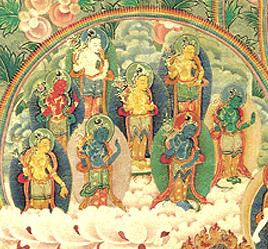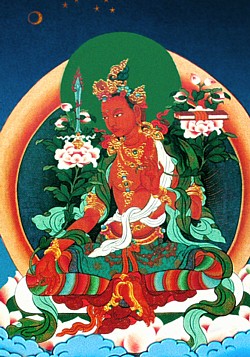Eight great bodhisattvas: Difference between revisions
Jump to navigation
Jump to search
No edit summary |
No edit summary |
||
| (30 intermediate revisions by 8 users not shown) | |||
| Line 1: | Line 1: | ||
[[Image:Bodhisattva.JPG|frame|Eight great bodhisattvas from the Longchen Nyingtik Field of Merit]] | <noinclude> | ||
'''Eight Great Bodhisattvas''', or 'Eight Close Sons' ([[ | [[Image:Bodhisattva.JPG|frame|Eight great bodhisattvas from the [[Longchen Nyingtik]] Field of Merit]] | ||
*[[Mañjushri]] | </noinclude> | ||
*[[Avalokiteshvara]] | '''Eight Great Bodhisattvas''', or 'Eight Close Sons' (Skt. ''aṣṭa utaputra''; Tib. [[ཉེ་བའི་སྲས་བརྒྱད་]], ''nyewé sé gyé'', [[Wyl.]] ''nye ba'i sras brgyad'') — the main [[bodhisattva]]s in the retinue of [[Buddha Shakyamuni]]: | ||
*[[Vajrapani]] | {{Tibetan}} | ||
*[[Maitreya]] | *[[Mañjushri]] | ||
*[[Kshitigarbha]] | *[[Avalokiteshvara]] | ||
*[[Akashagarbha]] | *[[Vajrapani]] | ||
*[[Sarvanivaranavishkambhin]] | *[[Maitreya]] | ||
*[[Samantabhadra]] | *[[Kshitigarbha]] | ||
*[[Akashagarbha, Bodhisattva|Akashagarbha]] | |||
*[[Sarvanivaranavishkambhin]] | |||
*[[Bodhisattva Samantabhadra|Samantabhadra]] | |||
<noinclude> | <noinclude> | ||
Each fulfils a particular role to help beings. Symbolically they represent the pure state of the [[eight consciousnesses]]. | Each fulfils a particular role to help beings. Symbolically they represent the pure state of the [[eight consciousnesses]]. | ||
==Qualities of the Eight Bodhisattvas== | ==Qualities of the Eight Bodhisattvas== | ||
[[Image:Manjushri.jpg|frame|The [[bodhisattva]] [[Mañjushri]]]] | |||
Although the eight bodhisattvas or ‘close sons of the Buddha’ all possess the same qualities and powers, each one displays perfection in a particular area or activity. | Although the eight bodhisattvas or ‘close sons of the Buddha’ all possess the same qualities and powers, each one displays perfection in a particular area or activity. | ||
*Manjushri embodies [[wisdom]]; | *Manjushri embodies [[wisdom]]; | ||
| Line 21: | Line 24: | ||
*Sarvanivaranavishkambhin purifies wrong-doing and obstructions; | *Sarvanivaranavishkambhin purifies wrong-doing and obstructions; | ||
*Maitreya embodies [[love]]; | *Maitreya embodies [[love]]; | ||
*Samantabhadra displays special expertise in making offerings and prayers of aspiration; and | *Samantabhadra displays special expertise in making offerings and [[Aspiration prayers|prayers of aspiration]]; and | ||
*Akashagarbha has the perfect ability to purify transgressions. | *Akashagarbha has the perfect ability to purify transgressions. | ||
[[Khenpo Chöga]] says: | |||
:Among the immeasurable qualities of the Buddha, eight of his foremost qualities manifest as the eight bodhisattvas: | |||
::1) the personification of the Buddha’s wisdom (Tib. <big>ཡེ་ཤེས་ཀྱི་རང་གཟུགས་</big>, Wyl. ''ye shes kyi rang gzugs'') is Bodhisattva Mañjuśrī; | |||
::2) the personification of the Buddha’s compassion (Tib. <big>སྙིང་རྗེའི་རང་གཟུགས་</big>, Wyl. ''snying rje’i rang gzugs'') appears as Bodhisattva Avalokiteśvara; | |||
::3) the personification of the Buddha’s power or capacity (Tib. <big>ནུས་པའི་རང་གཟུགས་</big>, Wyl. ''nus pa’i rang gzugs'') is Bodhisattva Vajrapāṇi; | |||
::4) the personification of the Buddha’s [[enlightened activity|activity]] (Tib. <big>ཕྲིན་ལས་</big>, Wyl. ''phrin las'') is Bodhisattva Maitreya; | |||
::5) the personification of the Buddha’s [[merit]] (Tib. <big>བསོད་ནམས་རང་གཟུགས་</big>, Wyl. ''bsod nams rang gzugs'') arises as Bodhisattva Kṣitigarbha; | |||
::6) the personification of the Buddha’s qualities (Tib. <big>ཡོན་ཏན་གྱི་རང་གཟུགས་</big>, Wyl. ''yon tan gyi rang gzugs'') appears as Bodhisattva Sarvanīvaraṇaviṣkambhī; | |||
::7) the personification of the Buddha’s [[blessing]]s (Tib. <big>བྱིན་རླབས་ཀྱི་རང་གཟུགས་</big>, Wyl. ''byin rlabs kyi rang gzugs'') arises as Bodhisattva Ākāśagarbha; and | |||
::8) the personification of the Buddha’s aspirations (Tib. <big>སྨོན་ལམ་གྱི་རང་གཟུགས་</big>, Wyl. ''smon lam gyi rang gzugs'') is manifest as Bodhisattva Samantabhadra.<ref>In ''Drops of Nectar: Khenpo Kunpal's Commentary on Shantideva's Entering the Conduct of the Bodhisattvas'', www.kunpal.org, vol. 1 p.282</ref> | |||
==Notes== | |||
<small><references/></small> | |||
==Further Reading== | |||
===In Tibetan=== | |||
*[[Jamgön Kongtrul Lodrö Tayé]], ''nye ba'i sras brgyad kyi rnam thar la bsngags pa bstod chen rgya mtsho rnam bshad'' | |||
*[[Mipham Rinpoche]], Tib. བྱང་སེམས་ཉེ་སྲས་བརྒྱད་ཀྱི་རྟོགས་བརྗོད་ནོར་བུའི་ཕྲེང་བ།, Wyl. ''byang chub sems dpa' chen po nye ba'i sras brgyad kyi rtogs brjod nor bu'i phreng ba'' (Translated by Lama Yeshe Gyamtso. See below) | |||
*Mipham Rinpoche, ''nye sras brgyad kyi sgrub pa rin chen gter bum'' | |||
===In English=== | |||
*Jamgön Mipham, ''A Garland of Jewels'', (trans. by Lama Yeshe Gyamtso), Woodstock: KTD Publications, 2008 | |||
** [https://dharmaebooks.org/garland-jewels/ Free eBook available from dharmaEbooks.org] | |||
==Internal Links== | |||
*[[Eight female bodhisattvas]] | |||
==External Links== | |||
*[http://all-otr.org/public-talks/48-the-eight-close-sons Brief presentation of the eight close sons by Orgyen Tobgyal Rinpoche] | |||
*[http://www.himalayanart.org/pages/bodhisattva/index.html Bodhisattva Outline Page at Himalayan Art] | |||
[[Category:Enumerations]] | [[Category:Enumerations]] | ||
[[Category:08-Eight]] | |||
[[Category:Eight Close Sons]] | |||
[[Category:Bodhisattvas]] | |||
[[Category:Buddhas and Deities]] | [[Category:Buddhas and Deities]] | ||
[[Category:Hundred Peaceful and Wrathful Deities]] | [[Category:Hundred Peaceful and Wrathful Deities]] | ||
[[Category:Buddha Shakyamuni's Disciples]] | |||
</noinclude> | </noinclude> | ||
Latest revision as of 15:11, 26 July 2024

Eight Great Bodhisattvas, or 'Eight Close Sons' (Skt. aṣṭa utaputra; Tib. ཉེ་བའི་སྲས་བརྒྱད་, nyewé sé gyé, Wyl. nye ba'i sras brgyad) — the main bodhisattvas in the retinue of Buddha Shakyamuni:
| This section contains Tibetan script. Without proper Tibetan rendering support configured, you may see other symbols instead of Tibetan script. |
- Mañjushri
- Avalokiteshvara
- Vajrapani
- Maitreya
- Kshitigarbha
- Akashagarbha
- Sarvanivaranavishkambhin
- Samantabhadra
Each fulfils a particular role to help beings. Symbolically they represent the pure state of the eight consciousnesses.
Qualities of the Eight Bodhisattvas

Although the eight bodhisattvas or ‘close sons of the Buddha’ all possess the same qualities and powers, each one displays perfection in a particular area or activity.
- Manjushri embodies wisdom;
- Avalokiteshvara embodies compassion;
- Vajrapani represents power;
- Kshitigarbha increases the richness and fertility of the land;
- Sarvanivaranavishkambhin purifies wrong-doing and obstructions;
- Maitreya embodies love;
- Samantabhadra displays special expertise in making offerings and prayers of aspiration; and
- Akashagarbha has the perfect ability to purify transgressions.
Khenpo Chöga says:
- Among the immeasurable qualities of the Buddha, eight of his foremost qualities manifest as the eight bodhisattvas:
- 1) the personification of the Buddha’s wisdom (Tib. ཡེ་ཤེས་ཀྱི་རང་གཟུགས་, Wyl. ye shes kyi rang gzugs) is Bodhisattva Mañjuśrī;
- 2) the personification of the Buddha’s compassion (Tib. སྙིང་རྗེའི་རང་གཟུགས་, Wyl. snying rje’i rang gzugs) appears as Bodhisattva Avalokiteśvara;
- 3) the personification of the Buddha’s power or capacity (Tib. ནུས་པའི་རང་གཟུགས་, Wyl. nus pa’i rang gzugs) is Bodhisattva Vajrapāṇi;
- 4) the personification of the Buddha’s activity (Tib. ཕྲིན་ལས་, Wyl. phrin las) is Bodhisattva Maitreya;
- 5) the personification of the Buddha’s merit (Tib. བསོད་ནམས་རང་གཟུགས་, Wyl. bsod nams rang gzugs) arises as Bodhisattva Kṣitigarbha;
- 6) the personification of the Buddha’s qualities (Tib. ཡོན་ཏན་གྱི་རང་གཟུགས་, Wyl. yon tan gyi rang gzugs) appears as Bodhisattva Sarvanīvaraṇaviṣkambhī;
- 7) the personification of the Buddha’s blessings (Tib. བྱིན་རླབས་ཀྱི་རང་གཟུགས་, Wyl. byin rlabs kyi rang gzugs) arises as Bodhisattva Ākāśagarbha; and
- 8) the personification of the Buddha’s aspirations (Tib. སྨོན་ལམ་གྱི་རང་གཟུགས་, Wyl. smon lam gyi rang gzugs) is manifest as Bodhisattva Samantabhadra.[1]
Notes
- ↑ In Drops of Nectar: Khenpo Kunpal's Commentary on Shantideva's Entering the Conduct of the Bodhisattvas, www.kunpal.org, vol. 1 p.282
Further Reading
In Tibetan
- Jamgön Kongtrul Lodrö Tayé, nye ba'i sras brgyad kyi rnam thar la bsngags pa bstod chen rgya mtsho rnam bshad
- Mipham Rinpoche, Tib. བྱང་སེམས་ཉེ་སྲས་བརྒྱད་ཀྱི་རྟོགས་བརྗོད་ནོར་བུའི་ཕྲེང་བ།, Wyl. byang chub sems dpa' chen po nye ba'i sras brgyad kyi rtogs brjod nor bu'i phreng ba (Translated by Lama Yeshe Gyamtso. See below)
- Mipham Rinpoche, nye sras brgyad kyi sgrub pa rin chen gter bum
In English
- Jamgön Mipham, A Garland of Jewels, (trans. by Lama Yeshe Gyamtso), Woodstock: KTD Publications, 2008
